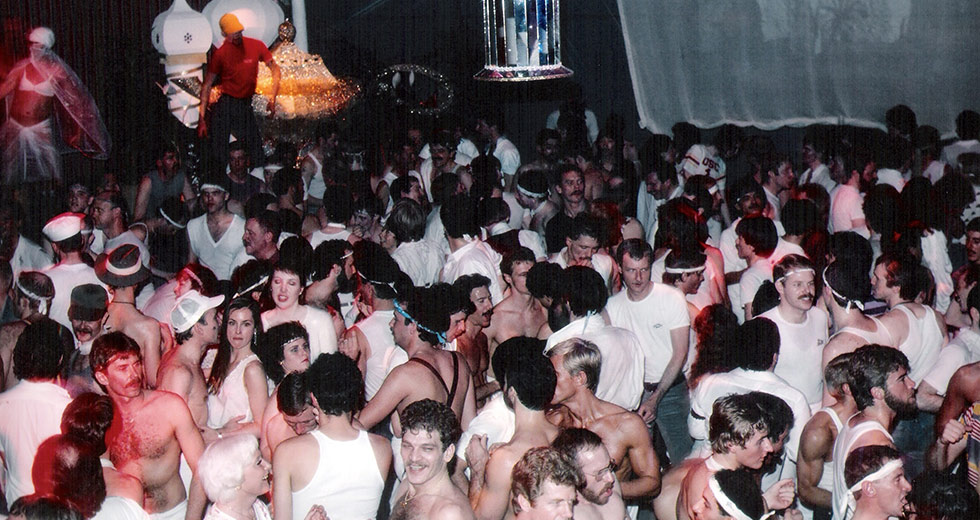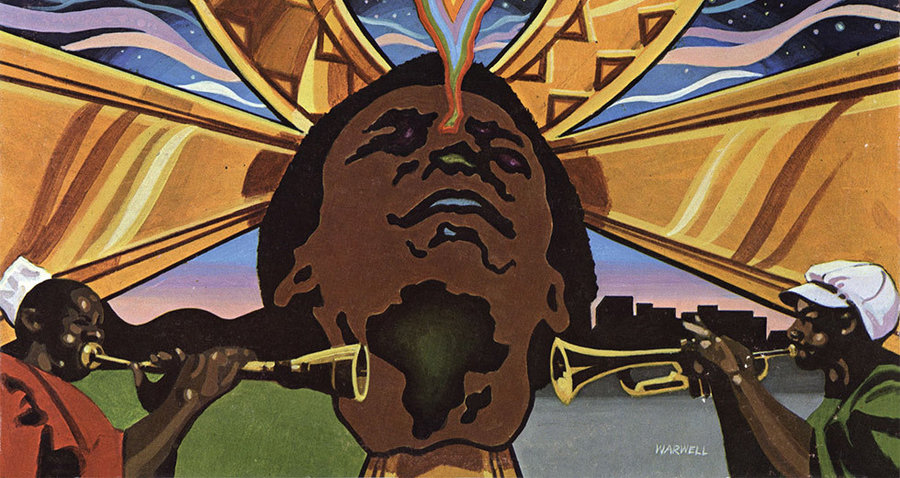Top 10: Exotica From Japan
“Exotica contrived a view of global culture that was so distorted, so outlandish, so dismissive of reality, as to be both surreal and absurd,” wrote David Toop in his exploratory book Exotica. In it, he connects the “Tokyo Boogie Woogie” of jazz singer Shizuko Kasagi from the ’60s to the ’80s “electro-Orientalism” of Yellow Magic Orchestra. It’s a similar mood of otherness that permeates both the ’60s girl pop of Nagoya twins The Peanuts and the steel pan music of Yann Tomita’s Astro Age Steel Orchestra. So while exotica in the West presents an unreal image of the Far East, Japanese artists have similarly looked to the outside world to create their own fabricated soundscapes. Here we look at ten artists responsible for milestones of Japanese exotica.
The Peanuts
Named The Peanuts because of their size, sisters Hideyo and Tsukiko Itō debuted with the 1959 song “Kawaii Hana” (a version of Sidney Bechet’s “Petite Fleur”). The twins’ star rose across the Far East after appearing in the now-cult monster movie Mothra. In it, they starred as two magical fairies that sang ethereal songs to a giant moth protecting a make-believe Polynesian island. Their LP The Hit Parade is possibly the ultimate expression of island-hopping Japanese exotica. This early ’60s outing featured a mambo version of a French song “Papa Aime Maman” sung in Japanese, and a Hawaiian pop take on Ricky Nelson’s “Hello Mary Lou.” Their status as the godmothers of J-pop was cemented when the group W released an EP, Koi No Vacance, covering songs from their golden age.
Shizuko Kasagi
Shizuko Kasagi’s first singing role was also her first acting one - her appearance in the 1948 film noir Drunken Angel brought her into Japanese living rooms. Filmed during the American occupation, this bold film also signalled the arrival of director Akira Kurosawa. In the film Kurosawa addresses the occupation and America’s influence on Japan; when Shizuko arrives in a nightclub scene to sing the primal “Jungle Boogie,” it was done to signify Japan’s identity crisis. But there was no doubting her love of American music in the series of records that followed, earning Shizuko the nickname “The Queen of Boogie.” And hits like “Tokyo Boogie Woogie” and “Kaimono-Boogie” (‘Shopping Boogie’) were important stepping-stones in Japan’s post-war jazz boom.
Izumi Yukimura
By the early ’50s, the Japanese public had developed an insatiable appetite for Latin music. Like artists such as Les Baxter and Arthur Lyman, Japanese musicians concocted a wild amalgam of Latin rhythms for an audience all too willing to believe the myth. One of the most famous singers to ride the Latin wave was Izumi Yukimura, whose cover of “Ain't Cha-cha Coming Out T-tonight” was more than matched by the 1955 hit “Milagros Del Cha Cha.” But her coup de grace was a version of “Blue Canary,” which had accompanying bird whistles and a haunting vocal seemingly tailor-made for a Quentin Tarantino Yakuza film. Further highlights include a stunning 1954 version of Arthur Lyman’s “Taboo.”
The Tokyo Cuban Boys
Formed by Tadaaki Misago in 1949, The Tokyo Cuban Boys helped introduce Latin music to Japan, playing covers of Latin originals and making their own Latin arrangements of Japanese pop hits. Like The Peanuts, The Tokyo Cuban Boys were not considered exotic in Japan at the time. But looking back now, LPs like their 1961 outing Cuban Spectacles sit perfectly next to the Latin exotica of Western artists like Les Baxter and Edmundo Ross. Despite their artifice, there was nothing lightweight about their playing. This was a serious group of musicians whose full force is heard best on “Mambo No. 9,” a great version of the Pérez Prado cut. Their 1966's Memories Of Japan and 1961's More Echoes of Japan were perhaps their most inventive releases, as they re-interpreted Japanese folk songs, like the sea shanty "Soran-Bushi," in a Latin style.
Harold Sasahara
The music of Hawaii was a recurring theme of exotica – most notably through Martin Denny and Arthur Lyman. But less is known about the exotica made by Hawaii’s Japanese Nisei community in the 1950s. A perfect starting point is the music of Harold Sasahara & Club Nisei Orchestra, especially their wonderfully breezy “Japanese Rumba"; they also released a version of “Sayonara” later re-recorded by Martin Denny. Harold Sasahara also collaborated with the Japanese Modernaires Orchestra – one of Hawaii’s biggest Nisei bands – on “Yuhi Wa Haruka (Far Away Sunset).” These Hawaiian Nisei bands were said to have influenced people like Haruomi Hosono of Yellow Magic Orchestra.
Haroumi Hosono
You can read far more about Haroumi Hosono in RBMA’s guide to the solo work of the members of Yellow Magic Orchestra, so we’ll just focus on his exotica period. Before forming YMO, Hosono recorded a series of LPs under the name Harry ‘The Crown’ Hosono; notably, Tropical Dandy and Bon Voyage Co marked him as the father of '70s Japanese exotica. But perhaps his greatest work in this genre was the 1978 LP Paraiso, recorded under the name Harry Hosono & The Yellow Magic Band and featuring Ryuichi Sakamoto and Yukihiro Takahashi. As with exotica musicians in the West, the music of Bali provided an opportunity for Hosono to show off his own faux Orientalism with the brilliant Gamelan hypnotics of “Shambhale Signal.” Meanwhile, the completely off-the-wall Thai-meets-Oklahoma rock & roll of his version of Wanda Jackson’s “Fujiyama Mama” is another pinnacle of Japanese exotica.
YMO
Hosono, Sakamoto, and Takahashi worked together again on the 1978 LP Pacific (also featuring future fusion artists Shigeru Suzuki and Tatsuro Yamashita), containing tracks like “Cosmic Surfin” that showcased their “electro-Orientalism." But it was their electro pop version of Martin Denny’s classic “Firecracker” (as Yellow Magic Orchestra) that really captured their Japanese exotica aesthetic. “I have an interest in Hawaiian culture, that mix of Western, Eastern, Chinese, Japanese, Polynesian, and American,” Sakamoto told The Wire in a 1994 interview. “And also that fake image of Asian culture – exotic, typical stereotype image – which Americans created in Hollywood!”
Yann Tomita
Yann Tomita first heard the steel pans on a Van Dyke Parks record in the 1970s before travelling to Trinidad to learn the instrument. At the end of the 1970s, he formed the über-cultish Tiny Exotic Boys. Although they never released a record, they did inspire the exotic explorations of Toshio Nakanishi. In 1983 Nakanishi invited Tomita to play steel pan and vibes on Snakeman Show’s Pithecanthropus Erectus; you can hear Tomita's spacey pan playing on classic pieces of exotica like “Jungle Flower” and “Tune from Rangoon.” (Tomita collaborated with Nakanishi again on the Water Melon Group LP Cool Music, which featured a version of Martin Denny’s hugely prophetic 1958 recording “Quiet Village.”) But it was the 1992 LP Music for Astro Age that saw his futuristic musical vision come to fruition. Mixing steel pan and electronics, his space age exotica on titles like “Theme Of Astro 2050 System” is why he’s often labeled the Japanese Sun Ra.
Frank Chickens
Like Haroumi Hosono, the Frank Chickens also heard something exotic in Wanda Jackson. Their brilliant 1984 version of “Fujiyama Mama” became a favourite of John Peel’s, helping make the band one of the leading names of Japanese synth pop. In 1984, the London based duo released the LP We Are Frank Chickens. The cover featured an exploding volcano and a group of Japanese men in suits running for cover while Kazuko Hohki and Kazumi Taguchi look on. Tellingly, they pay tribute to The Peanuts with “Mothra” and a wonderfully surreal version of “Blue Canary.” On their next LP, “Yellow Toast” was a brilliant comment on Western stereotyping of the Japanese: “Oh we like being foreign nips, because you all think we are hip, but if you think we are wise, why don’t you look us in the eyes?”
Havana Exotica
Whereas groups like Pizzicato Five certainly created distorted Japanese versions of ’60s pop and bossa nova, their neo lounge music was too authentic to be viewed as exotic. Havana Exotica, on the other hand, sits next to the more “out there” pop of The Peanuts, Yann Tomita, and The Doopees (two helium-voiced pop singers Tomita championed). Produced by Tomita, their Japanese-only 1991 LP is a wonderful collection of exotic synth pop and Space Age easy listening. Tracks like “Surfin’ on M.O.O.G.” sound like a natural successor to both The Peanuts and Frank Chickens. With sparse Moog licks and shards of drum machine beats scattered around a playful vocal, it was the standout of the 1996 LP Sushi 3003 - A Spectacular Collection of Japanese Clubpop. Later, band members Sugar Yoshinaga and Yumiko Ohno would go on to form Buffalo Daughter.

